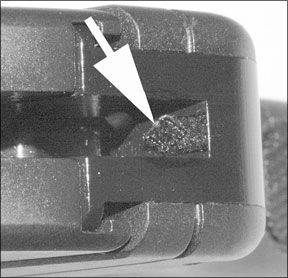Ruger has issued a recall on the extremely popular new LCP 380 auto. The problem seems to be that it’s possible for the gun to discharge if dropped. In Ruger’s words, they’ve received a small number of reports to the effect that the gun, “…can discharge when dropped onto a hard surface with a round in the chamber.” The company has offered a retrofit of a different hammer mechanism to cure the problem. This will be at no charge to the 288 customer, and details how to proceed may be obtained via email to: LCPRecall@ruger.com, or by phone to the “recall hotline” at (800) 784-3701. For your troubles, you’ll also receive a free new magazine with a finger extension, like the one that came with one of the Kel-Tec’s two magazines.
If your gun already has the retrofit, it will be identified either by the addition of a diamond to the bottom of the hammer cut in the frame, or by the prefix “371” in the serial number.
We tested two Ruger LCP 380 ACP pistols in June 2008 and one of them had a problem with torn case rims. This was an early issue of the gun, and Ruger has fixed that problem completely. All later guns have a milled notch to give clearance to the ejected empties. Because Ruger has been swamped with orders for the LCP, we thought it would be a good idea to give one of the retrofitted guns a long look, and compared it with the one previously tested in Idaho.
We found a few small changes. The firing-pin hole of the newer gun seems to have been drilled through the slide at a different angle. While we could see no drastic differences between the two hammers, we could feel quite a difference. With the guns disassembled and the hammers cocked, when we shoved rearward on each hammer there was a pronounced reluctance for the new hammer to move in that direction. The older, non-modified gun permitted the hammer to move rearward much easier. The new gun’s hammer made a ratcheting sound, and the old one didn’t. We suspect that’s significant.
The slide-lock button has now been rounded, which makes it slightly easier to use. The new gun came with only one magazine, but it had two floorplates. There was a flat one, as on the original gun, and one with a finger extension to help get a grip on the small powerhouse. The new gun also had a blued barrel, while the first versions had white-finished stainless. The inside of the chamber mouth, under the hood, was quite smooth.
Our original sample gave us occasional failures to feed until we polished that area under the chamber extension or hood. We found no differences in velocity between old and new. Accuracy and reliability were fine in the new gun, for the duration of our very limited testing. If your gun is one that needs attention—and that includes all the 370-serial number prefixes that don’t have the little diamond—we strongly suggest you contact Ruger and have this potential problem repaired. —Ray Ordorica

























